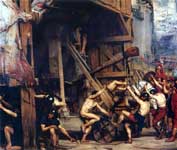.
”Archimedes,” said Lucius, “we know that without your war machinery Syracuse wouldn’t have held out for a month; as it is, we’ve had a rough two years because of them. Don’t think we soldiers don’t appreciate that. They’re superb machines. My congratulations.”
Archimedes waved his hand. “Please, they’re nothing really. Ordinary hurling mechanisms—mere toys, that’s all. Scientifically, they have little value. Karel Capek, Apocryphal Tales
Bows (the first machine invented by man?) were used at least since 8000 BC according to cave paintings in 'les Dogues' (Castellón, France). Probably bows were invented much earlier (around 20000 BC). The word Catapult comes from the Greek words kata and peltes. (Kata means downward and peltes describes a small shield ). Catapult means therefore shield piercer. Catapults were first invented about 400 BC in the Greek town Syracus under Dionysios I (c. 432-367 BC). The Greek engineers first constructed a comparatively small machine, the gastraphetes (belly-bow), a version of a crossbow. The gastraphetes is a large bow mounted on a case, one end of which rested on the belly of the person using it. When the demands of war required a faster, stronger weapon, the device was enlarged, and a winch pull-back system and base were added.
Technology of Catapults (belopoietic from belos (arrow or it is better to say a bolt) and poiw make) was a key part of ancient mechanics, a branch of mathematics that also included fortification building, statics, and pneumatics.
Many, though, have begun the construction of weapons of the same size, and have made use of the same system of rules, the same types of wood, and the same amounts of iron, and have kept to the same weight, yet of these some have made machines that throw their missiles far and with great force, while those made by others have lagged behind their specifications. When asked why this happened, the latter have been at a loss for an answer. So it is appropriate to warn the prospective engineer of the saying of Polykleitos the sculptor: perfection, he said, comes about little by little [para mikron] through many numbers. And in the same way, as far as concerns our science, it happens that in many of the items that go to make up the machine a tiny deviation is made each time, resulting in a large cumulative error. Philo Mechanicus
Later, weapons fired by torsion bars powered by horsehair and ox tendon (the Greeks called this material neuron ) springs could fire arrows, stones, and pots of burning pitch along a parabolic arc. Some of these machines were quite large and heavy and this were thus mounted on wheels to improve tactical mobility and deployment. The production method is not known.
Interesting is also this information:
“When horse-hair and other materials failed, the women in several instances cut off their own hair and twisted it into ropes for the engines (Caes. BC iii.9; Veget. De Re Mil. iv.9). William Smith, D.C.L., LL.D.: A Dictionary of Greek and Roman Antiquities, John Murray, London, 1875.”
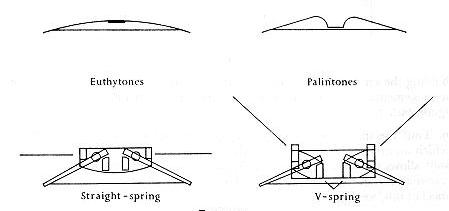
A palintonon or palintone translates as "V-spring" and euthytonon or euthytone (Ευθύτονος) translates as "straight-spring" from Greek. The "V" or straight spring refers to how siege engines are compared to shape of hand-held bows when it comes to how the arms are shaped.
Main Categories
-
Flexion
-
Torsion
Objects Thrown
-
Arrows
-
Stones. (lithobolos (Λιθοβόλος) i.e. stone thrower)
-
Other. “When a rampart composed of the trunks of trees is raised opposite to a wall, it may be consumed by discharging red hot iron bars against it from the balistae. “ Marcus Vitruvius Pollio: de Architectura
-
Flexion based Artillery
-
Arrow
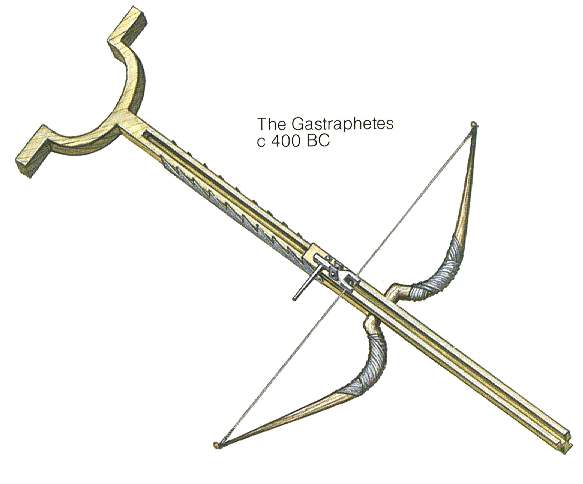
The Gastraphetes (γαστραφέτης), a form of primitive crossbow that fired a wooden bolt on a flat trajectory along a slot in the aiming rod. Main components (syrinx / pipe and diostra / slider). Could reach a bow length of 15 feet and could fire a stone of 40 pounds some 200 to 300 yards. Mainly known from Heron of Alexandria references. It was used successfully during the siege of Motya, a Carthaginian island fortress on the west end of Sicily, in 397 BC and Greek engineers improved further the capabilities of the device reaching its physical limitations. The army of Dionysius I surprised the Carthaginias with the newly developed gastraphetes with its larger range. The desciption of Heron of Alexandria is based on an older by Ctesibius.
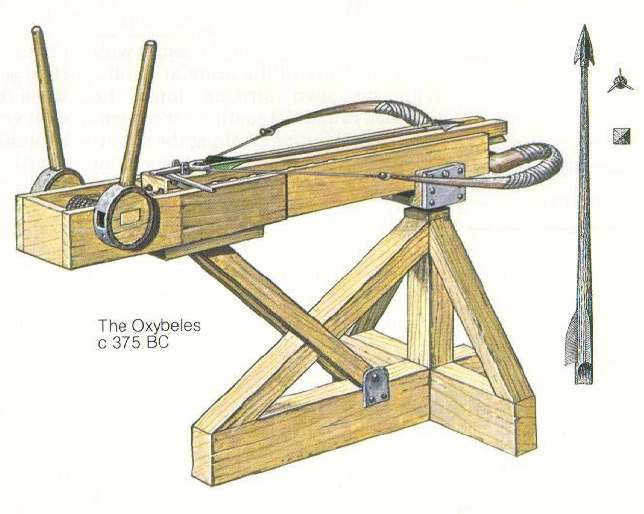
Oxybeles (Οξυβόλος) (Greek word that means bolt shooter)
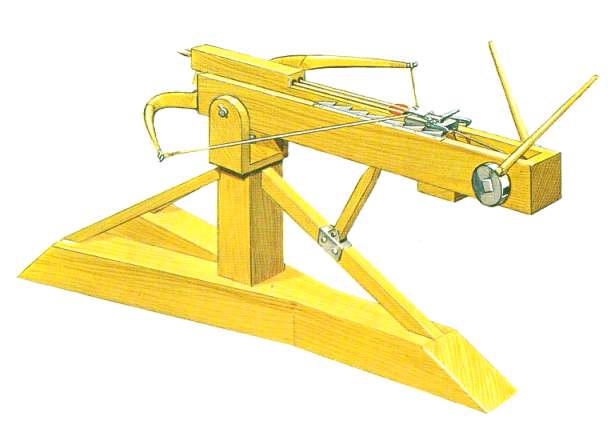
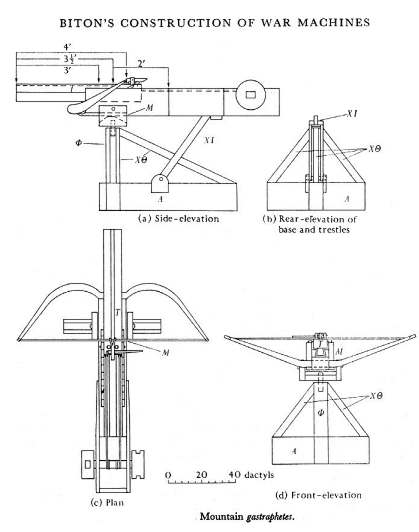

Zopyrus's gastraphetes from Zopyrus a specialist in gastraphetes design from Tarentum Southern Italy. A step towards the torsion catapult, including a stand for the heavy gastraphetes version.
-
Stone

The stone thrower of Charon of Magnesia
Biton addressed his artillery treatise to king Attalus I of Pergamum (241 to 197 B.C.),
The Roman army had stone-throwers capable of hurling projectiles weighing 27 kg across a distance of 150 meters. Archimedes' legendary engines are said to have used stones three times as heavy. Plutarch tells us that it was Hiero, another king of Syracuse, who spurred Archimedes into military engineering. His splendid catapults kept the Roman troops at bay until the besieged city fell in 212 B.C. as a result of treachery.
The engineers saw themselves as an international community: Philo mentions his exchanges with colleagues in Alexandria and Rhodes, Biton his colleagues from Magnesia, Abydos, Macedonia, and Colophon. They also traveled: for instance, Zopyrus, a specialist in belly-bow design from Tarentum in Southern Italy, created one design in Miletus (Asia Minor) and another in Cumae (central Italy)
-
Torsion based Artillery
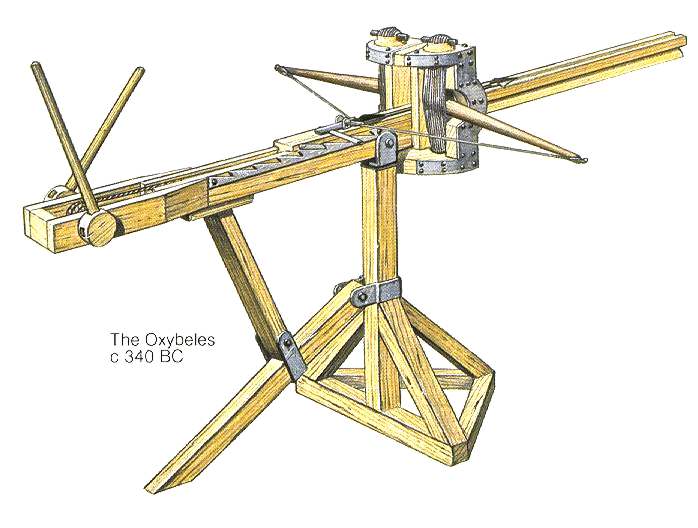
The principle of torsion was probably discovered by artificers working in Macedonia under Philip II and Polyidus between 353 and 341 BC. There exists no hint of torsion catapults before Philip's reign. Ath the siege of Perinthus and Byzantium (340 BC) Philip deployed torsion arrow-shooting catapults. Marsden, Invention of the catapult
Torsion catapults probably around 340 BC. Inscriptions from the Chalkothek on the Acropolis of Athens mentions torsion spring catapults at about 330 BC. Oxybeles could pierce a shield and armor of warrior in 400 meter distance.
It was Philip of Macedon who first organized a special group of artillery engineers within his army to design and build catapults. Philip's use of siegecraft allowed Greek science and engineering an opportunity to contribute to the art of war, and by the time of Demetrios I (305 B.C.), known more commonly by his nickname "Poliorcetes" (the Besieger), Greek inventiveness in military engineering was probably the best in the ancient world.
Alexander the Great used catapults in a completely different way -- as covering artillery. Alexander's army carried prefabricated catapults that weighed only 85 pounds. Larger machines were dismantled and carried along in wagons. Alexander's engineers contributed a number of new ideas. Major Greek cities adopted the use of catapults and owned a park of torsion artillery.
210 BC
Philo of Byzantium ; refers casually (Pol. 91. 36) to one-armed stone-throwing machines (later Roman versions also called onager)
Euthyntonon
Light Arrow Catapult
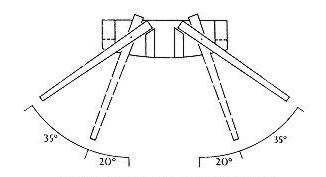

Euthyntonon, Torsion weapon
(T: Choinikides / Washers)
Palintonon (or Ballista in Roman)
Heavy Artillery Weapon up to 3 tons weight (Transport in pieces). 13 kg stone (Two lever) Around 335 BC.
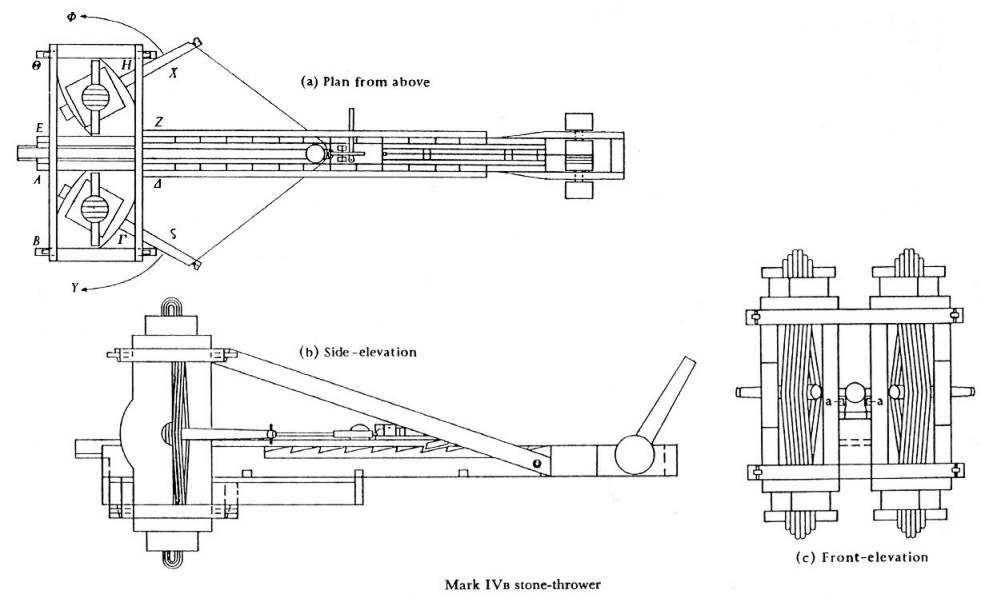
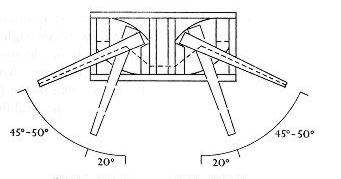
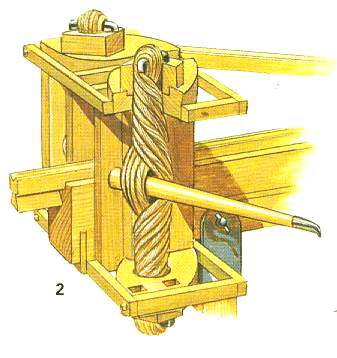
Spherical stones (10-80 pounds)
Palintonon
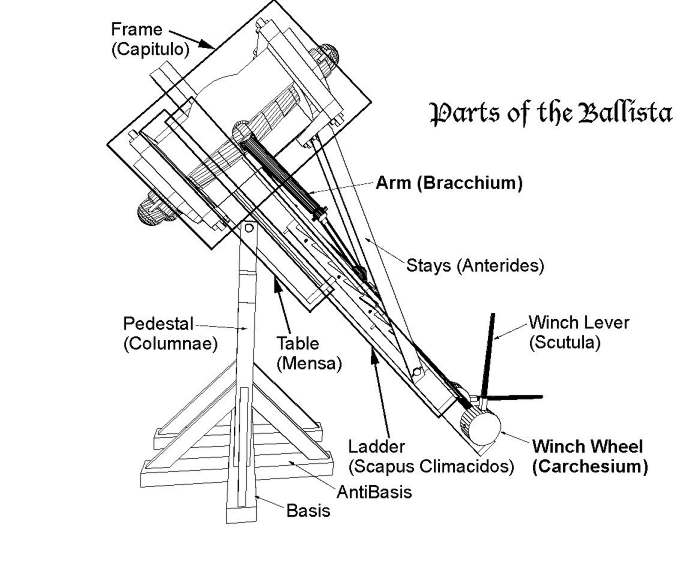

Palintonon. Plans from "Build Your Own Greek Siege Engine" by Kurt Suleski
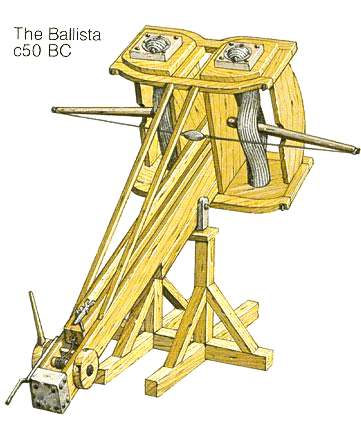
Cheiroballista (Two lever)
Introduction of metal frames.
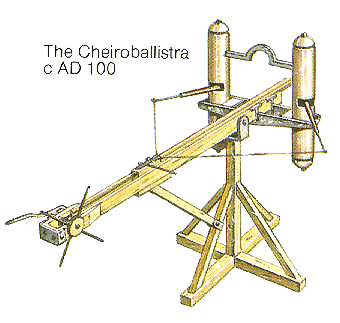
The Cheiroballistra (called Manuballista by the Romans), a device that hurls arrows over a large distance. Some say that it was actually written around 100 AD (after Heron). As an inventor Apollodorus of Damascus is proposed working for the Roman army.
In this particular engine, the springs are stretched in two separate metal casings. A metal stud was attached the top of each of the field frames, to hold them together. Another stud was attached to the bottom of the field frames and the base of the engine, to hold the spring casings in place (Marsden 209). Heron's cheiroballistra represents the most advanced two-armed torsion engine used by the Roman army.
Dionysius Repeating Catapult (Polybolo)
The repeating Catapult developed in the 3rd century BC was too complicated to be used widely.
Remarks
Only few metallic parts of catapults survived and projectiles (stones, bolts).
Engineers at Rhodes were known to have produced a palintonon that could shot stones and also arrows
The use of catapults in the field is evidenced in one of Alexander's early battles in the Northern Marches of Macedon. At Pelion, Alexander, in a rare loss of the initiative had to extract his army from a siege position around the town and cross a river to a defensive position in the foothills. Surrounded, Alexander lulled the barbarian army into watching his phalanx and cavalry maneuver on the plain outside of the city, then in a typical lightening move, he forced a crossing of the river creating a defensive bridgehead. He then set up some of his siege artillery to fire back across the river, over the heads of his own troops to cover their rear with a curtain of missiles as they crossed the river after disengaging with the enemy. This is the first reported use of siege artillery in the field as an assault weapon (in spite of the fact that it was used defensively). Alexander the Great and His Army
In 334 BC Alexander the Great used at the siege of Halicarnassus heavy palintona. At Tyre he used arrow catapults and palintona against the wall fortifications. http://www.perseus.tufts.edu/cgi-bin/ptext?doc=Perseus%3Atext%3A1999.04.0009&layout=&loc=16.10.html
At the siege of Gaza in 332 BC. Alexander was wounded in the neck by a catapult arrow that had pierced both his shield and his breastplate.
Philo of Byzantium, in an artillery manual written in about 200 B.C., stated that a wall had to be at least 4.62 meters thick to withstand catapult stones and that it was a good idea to keep the stone throwers at least 150 meters distant by means of ditches and other obstacles.
The palintonon could fire a stone over a range greater than that of a Napoleonic cannon.
It is interesting to note that the largest stone-thrower on record, a three-talent (78 kilogram) machine, was built by Archimedes.
In honor of the Greek contributions, to this day the military art of siege warfare is called poliorcetics.
The main catapult significance according to O'Connell is that it: embodied the deliberate exploration of physical and mechanical principles to improve armaments.
The Syracusia probably the largest transport ship designed by Archias of Corinth around 240 BC with the help of Archimedes had eight deck towers including a 18-foot arrow or 180 pound stone catapult build by Archimedes (One if not the largest catapults used on a ship?). Crew that use the Catapults: Katapeltaphetai (Catapultists) equivalent of today naval gunners. Demetrius's Poliorcetes probably used for the first time catapults on his large warships against the fleet of Ptolemy I at Salamis in Cyprus in 306 BC (His catapults could even use 78 kg stones as projectiles (superheavy category), although a wide range of stone balls have been found , with around 3kg as light category)
The Romans inherited the Catapult Technology from the Greeks and developed new types such as the onager. As many as 10 Catapults and 60 Ballistae were assigned to each legion.
The Steam Canon of Archimedes
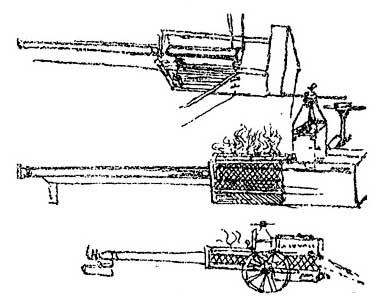
Archimedes Canon, Leonardo Da Vinci:
The catapult development started in Sicily with the Greek tyrant Dionysios I providing the financial means required for the experiments that were necessary to find the optimal design. Except in Sicily , Rhodes and Alexandria were the main centers of the development of the catapult technology, in Alexandria advanced by the support of the Greek Ptolemaic kings of Egypt. In the end of the first century AD the Roman engineer Sextus Frontinus wrote in Strategemeta that the war devices have reached their [physical] limits a long time ago and there is no hope for improvements.
There were unique devices produced by Archimedes such as a catapult that used steam power and in principle was a canon. It was described by Cicero in a manuscript discovered in a church library by Francisco Petrarch (1304 -1374). Petrarch collected Greek and Roman manuscripts neglected in various libraries for many centuries: His remark: "
"Each famous author of antiquity whom I recover places a new offence and another cause of dishonor to the charge of earlier generations, who, not satisfied with their own disgraceful barrenness, permitted the fruit of other minds, and the writings that their ancestors had produced by toil and application, to perish through insufferable neglect. Although they had nothing of their own to hand down to those who were to come after, they robbed posterity of its ancestral heritage"
Leonardo's quotations from books and his lists of titles supply nothing more than a hint as to his occasional literary studies or recreations. It was evidently no part of his ambition to be deeply read and he more than once expressly states that he did not recognise the authority of the Ancients, on scientific questions, which in his day was held paramount. Archimedes is the sole exception, and Leonardo frankly owns his admiration for the illustrious Greek to whose genius his own was so much akin. The Notebooks of Leonardo Da Vinci
Architronito e una macchina di fino rame, invenzlon d' Archimede. Leonardo Da Vinci:
The Cicero manuscript later was used by Leonardo Da Vinci who called the device "Architronito" in honour of Archimedes. He produced only drawings of the steam gun but Ioannis Sakas, a Greek expert of the work of Archimedes used this information to build a test device in 12.5.1981. A vessel was heated and when it reached 400 degrees Celsius 6 g of water was enough to produce in 10 seconds steam that expanding could throw a tennis ball size stone 50 meters. The reconstructed Archimedes steam gun by Sakas was only 1/5 the size of the original.
http://www.ellinikiestia.gr/PTYXES/antechn/atmotilebolo-toy-arximidi1.jpg
A Greek newspaper reported 3 days later about the result of the experiment of Sakas. From another Greek website the numbers which are given for the original is that it was able to shoot a 23 kg stone in 1100 meters and it was invented by Archimedes probably around 213 BC one year before his death. The Greek expert Evangelos Stamatis provided even a better performance estimate: 1.2 km for a 36 kg object. As Cicero reports Archimedes experimented with various devices to be used against the Romans (See for example the burning Mirrors). If and how the device was used by the Greek Syracuseans in practice and why such a device was not used or developed further by the Romans is unknown.
Famous Catapult Engineers or Authors
- Polydias, Diades of Pella and Charias (working for Philip and Alexander the Great).
- Diades helped Alexander at the sieges of Halicarnassus (334 BC) and Gaza (332 BC). He constructed various siege engines.
- Zopyrus of Tarentum (Ζώπυρος ο Ταραντίνος), Charon of Magnesia (Χάρων ο Μαγνήσιος), Philon of Byzantium (Φίλων ο Βυζάντιος), Biton (Βίτων), Ctesibius of Alexandria (Κτησίβιος ο Αλεξανδρεύς), Archimedes of Syracuse (Αρχιμήδης o Συρακούσιος), Dionysius of Alexandria (Διονύσιος ο Αλεξανδρεύς), Hero of Alexandria (Ηρων ο Αλεξανδρεύς), Vitruvius.
(Heron, Philon, Biton and Vitruvius are the main sources of information about ancient Catapults)
Philon of Byzantium c. (280-220) BC
Mechanics treatise "Mechanike syntaxis" (9 books) (250 BC)
1. Introduction
2. On the lever
3. On the building of seaports
4. On catapults *
5. On pneumatics *
6. On automatic theatres
7. On the building of fortresses *
8. On besieging and defending towns *
9. On stratagems
-
books that survived
Interesting Remarks
The word "Bombarde" comes from the Greek bombos i.e. bee meaning a loud humming sound.
The word ballistic comes from the Greek ba'llein, "throw"
Movement tends to create fire in wood, stone, and iron; and with even more reason should it have that effect on air, a substance which is closer to fire than these. An example is that of missiles, which as they move are themselves fired so strongly that leaden balls are melted; and if they are fired the surrounding air must be similarly affected. Aristotle, On the Heavens Book II Chapter 7
The Defense of Syracuse by Archimedes, Polybius
References
E.W. Marsden, Greek and Roman Artillery. Historical Development, 48-64. (PDF File)
E. W. Marsden, Greek and Roman Artillery: Technical Treatises (Clarendon Press, Oxford, 1971).
Dietwulf Baatz. Bauten und Katapulte des römischen Heeres
Biton, Belopoietics
O'Connell, Robert L. Soul of the Sword. New York: The Free Press 2002.
D L Simms, Archimedes' weapons of war and Leonardo, British J. Hist. Sci. 21 (1988) 195-210
CHAPTER XII: THE STRINGING AND TUNING OF CATAPULTS (Vitruvius) – Perseus
Ancient Catapults, Scientific American
A 1740 engraving of Archimedes planning the defenses of Syracuse. The Greek writing on his cap is Archimedes the geometer. This and other higher resolution images from http://www.mcs.drexel.edu/~crorres/Archimedes/Pictures/ArchimedesPictures.html#siege
Roman siege of Syracuse by Marcellus in 214 BC (Livy 24.33-34 PDF File);
Alexander the Great and His Army
Catapults or Scorpiones, Ballistae, The Stringing and Tuning of Catapults, Siege Machines
The Tortoise, Hegetor's Tortoise, Measures of Defence. From Book 10, Vitruvius
Books, References
William Gurstelle , The Art of the Catapult: Build Greek Ballistae, Roman Onagers, English Trebuchets, and More Ancient Artillery ,Chicago Review Press (July 1, 2004) ISBN: 1556525265
(for students with drawings and explanations)
Duncan B. Campbell, Brian Delf (Illustrator), Greek and Roman Artillery 399 BC - AD 363 , Osprey Publishing, Limited 2003, ISBN: 1841766348

F.E. Winter, Greek Fortifications. Toronto: University of Toronto Press , 1971
Josiah A. Ober, Fortress Attica: Defense of the Athenian Land Frontier 404-322 B.C. Leiden: E.J. Brill. 1985
Josiah A. Ober, Early Artillery Towers: Messenia, Boiotia, Megarid. American Journal of Archaeology , 91, 569-604. 1987
Historical / Fantasy Novels
The Arrows of HerculesThe Siege of Tyre Πολεμική Τεχνολογία στην Αρχαία Ελλάδα : Τα Τηλεβόλα και οι Αρχές της Βλητικής
| Ancient Greece
Science, Technology , Medicine , Warfare, , Biographies , Life , Cities/Places/Maps , Arts , Literature , Philosophy ,Olympics, Mythology , History , Images Medieval Greece / Byzantine Empire Science, Technology, Arts, , Warfare , Literature, Biographies, Icons, History Modern Greece Cities, Islands, Regions, Fauna/Flora ,Biographies , History , Warfare, Science/Technology, Literature, Music , Arts , Film/Actors , Sport , Fashion --- |

